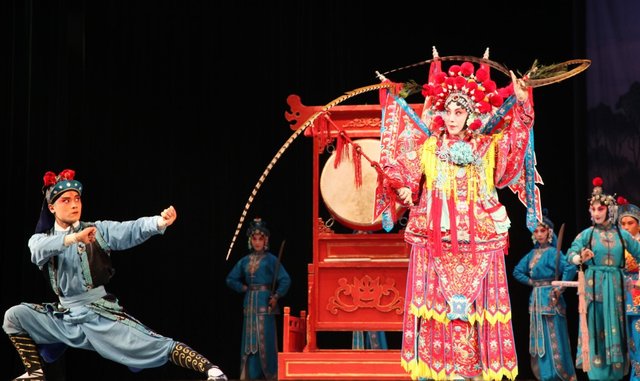The Chinese opera is a form of drama and music theatre in China. This performance goes back in History, and it has taken root in schools and the society. Chinese opera is a fusion of many forms of art that have existed in China over the years. Most of the early forms of the Chinese opera were simple but as time goes by, they have become defined and dramatic.
The opera is one of the most dramatic types of art in the world. It has undergone some gradual changes through the years, and this has given rise to different types of Chinese opera. Examples are the Kun opera, Qinqiang opera, Yue opera, Beijing opera, Huangmei Opera from Shaanxi and the Yu opera. There are different props in the performance. In the Chinese opera, the facial makeup includes dramatic masks and paint their faces to portray their character and show their emotional stance.
This type of art evolved from performances like dances, folk songs, music and speech. As time went by, all these elements combined into one performance that portrayed the Chinese culture. Music art and literature liaised together on the stage. The common types of instruments in these performances are the gong, erhu, melodies and the lute. There are different forms of facial makeup that are common in the performance. These are distinctive paint marks on the face.
The designs are exaggerated and they symbolize the character of the performer. The paintings also show a characters fact end role in the play. The facial paintings tell a story. People can know what is going on in the stage by observing the facial paintings. For example when a person has red on their face. It shows that they are brave and loyal.
A person with a black face is valiant. Yellow and white faces represent duplicity while gold and silver faces are mysterious. The painting meanings also depends on the use of lines. The larger the prominent color in the role, the more the role that the character assumes (Gaze np).
One of the performances is the peony Pavilion which is a famous Chinese opera. This performance can take up to 22 hours and it is a romantic 16th century performance. The peony Pavilion on most occasions took pace in the garden because during its inception in the 1598, there were no stages. People revived the garden opera in the 20th century and the play sold out because people were so eager to attend it (Lunden). This performance makes use of makeup in the cast.
The Chinese mask is a must have in the opera. Sometimes the performers paint their faces or wear masks. There are different masks that the performers in the opera use. There are language and geographical barriers between Western Art and Chinese art. However, the mask is presents in both forms of art. It reminds the audience of their heritage, history and culture. All the masks have a different meaning depending on their main color. One of their role is that they show different characters of the performer. They also illustrate the character’s emotional disposition and state. Pink masks show that the character is funny and playful. Blue is steadfast and it represents loyalty. Black shows that the character is rough, impartial and fierce.
Black masks represent the skin of Lord Abo. People said that his skin was originally black. His face mask is black even in the performances. The color black became a representation of fairness, courage, integrity, honesty and straightforwardness. A yellow mask denotes fierceness and ambition. Green shows that the character is violent, reckless, impulsive and lacking self-control and restraint. The bandits and the lords wear green masks. White portrays that the individual is treacherous, sinister, evil and crafty.
In Chinese opera, the people who wear white are in most instances the villains. In history, one of the villain was the chancellor of the Han dynasty. White also signifies old people like eunuchs, monks and generals. Red has the characteristics of loyalty, courage and uprightness. In Chinese opera red is positive color and the performers associate it with positive qualities. Sometimes they combine red with black and this shows sincerity and bravery. Red represents gallantly and it represents the celestial beings. Blue characterizes the same qualities as green. Blue can also express that the individual is cunning and sinister. Purple shows that the character is solemn, serious and professional. Purple also embodies loyalty and justice. Sometimes the ugly people wear purple masks (Theatre np).
In conclusion, the Chinese opera is one of the oldest forms of art. There are different types of operas that have cropped up gradually. All these have the same makeup. The facial makeup includes dramatic masks and facial paintings to portray the characters and show their emotional stance. Different colors of masks have different meanings and people who watch the performance can know what the story is about by just looking at the masks. The makeup and the masks also helps to keep the audience entertained and eager to watch the performance. The facial paintings also depict different characters of the actor. The most prominent color on the face is the one that acts an indicator. In the facial paintings, lines are also of paramount importance when people are assessing the character of the actors and actresses. The facial masks and makeup set apart Chinese opera from the other operas.
Works Cited
Gaze, China. 'The Secret Of Masks In Chinese Opera | China Gaze'. Chinagaze.com. N. p., 2013. Web. 5 Jun. 2014
Lunden, Jeff. 'The Peony Pavilion: A Vivid Dream In A Garden'. NPR.org. N. p., 2012. Web. 5 Jun. 2014.
Theatre, Court. 'Beijing Opera Masks'. Eventfinda. N. p., 2014. Web. 5 Jun. 2014.


